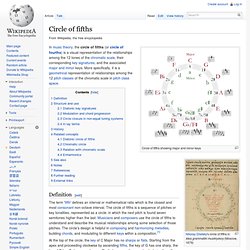

Music/resources.
Theory. Circle of fifths. Circle of fifths showing major and minor keys Nikolay Diletsky's circle of fifths in Idea grammatiki musikiyskoy (Moscow, 1679) In music theory, the circle of fifths (or circle of fourths) is a visual representation of the relationships among the 12 tones of the chromatic scale, their corresponding key signatures, and the associated major and minor keys.

More specifically, it is a geometrical representation of relationships among the 12 pitch classes of the chromatic scale in pitch class space. Definition[edit] Structure and use[edit] Pitches within the chromatic scale are related not only by the number of semitones between them within the chromatic scale, but also related harmonically within the circle of fifths. Octaves (7 × 1200 = 8400) versus fifths (12 × 700 = 8400), depicted as with Cuisenaire rods (red (2) is used for 1200, black (7) is used for 700). Diatonic key signatures[edit] The circle is commonly used to represent the relationship between diatonic scales. Play . How Music Works. Schillinger System. The Schillinger System of Musical Composition, named after Joseph Schillinger, is a method of musical composition based on mathematical processes.

It comprises theories of rhythm, harmony, melody, counterpoint, form, and semantics (emotional meaning, as in movie music). It offers a systematic and non-genre specific approach to music analysis and composition, a descriptive rather than prescriptive grammar of music. The Schillinger System might have served as a road map for many later developments in music theory and composition.
Instead, it languished in relative obscurity. Schillinger's career[edit] Schillinger was a professor at The New School in New York City and taught such celebrated musicians as George Gershwin, Glenn Miller, Benny Goodman, and a host of Hollywood and Broadway composers. In New York, Schillinger flourished, becoming famous as the advisor to many of America's leading popular musicians and concert music composers. After Schillinger[edit] Beyond style[edit] Key Color. Pentatonic scale. Pentatonic scale in Ravel's Ma Mère l'Oye III.

"Laideronnette, Impératrice des Pagodes", m.9-13.[1] Play Presumably D♯ minor pentatonic. Pervasiveness[edit] Types of pentatonic scales[edit] Hemitonic and anhemitonic[edit] Minyō scale on D,[5] equivalent to yo scale on D,[6] with brackets on fourths Play . Miyako-bushi scale on D, equivalent to in scale on D, with brackets on fourths[7] Play . Ethnomusicology commonly classifies pentatonic scales as either hemitonic or anhemitonic. Major pentatonic scale[edit] Anhemitonic pentatonic scales can be constructed in many ways. Another construction works backward: It omits two pitches from a diatonic scale. Minor pentatonic scale[edit] Because of their simplicity, pentatonic scales are often used to introduce children to music.
Five black-key pentatonic scales of the piano[edit] Music Practice Tips. Music Practice Tips 5 Powerful Shortcuts to Successful Music Practice Times Here are 5 simple things you can do that can make a huge difference in how you progress on your musical instrument.

These techniques apply to all instruments -- not just piano -- from flute to drums to guitar to voice to singing. Put them into practice today and stick with them. They are entirely logical, and after awhile you'll wonder why you didn't always practice this way. 1. 2. 3. 4. 5. There are many other practice tips we could get into, but these 5 will take you a long way toward successful practice of your music. If you have always wanted to play the piano but never had the opportunity, the very best way for adults to learn to play the piano is to use a combination of methods -- a synergy of reading the melody (the tune of the song) and then adding the harmony by knowing and understanding chords and chord styles. Crash Course In Exciting Piano Playing For Beginning Adults.